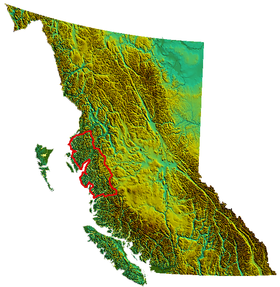| Kitimat Ranges | |
|---|---|
| French: Chaînons Kitimat | |
 Lax Kw'alaams backdropped by Mount McNeil | |
| Highest point | |
| Peak | Howson Peak |
| Elevation | 2,759 m (9,052 ft) [1] |
| Coordinates | 53°50′N128°30′W / 53.833°N 128.500°W |
| Dimensions | |
| Area | 62,777 km2 (24,238 sq mi) |
| Geography | |
| Location | British Columbia, Canada |
| Range coordinates | 53°49′59″N128°30′05″W / 53.83306°N 128.50139°W [2] |
| Parent range | Coast Mountains |
The Kitimat Ranges are one of the three main subdivisions of the Coast Mountains in British Columbia, Canada, the others being the Pacific Ranges to the south and the Boundary Ranges to the north.

